
(Delbert J. Larson)
Dedication.
I wish to dedicate this work to the memory of John E.
Chappell, Jr. In all my travels I have never met anyone so singly and heroically
devoted to debunking the special theory of relativity. John led a difficult
life, made difficult largely because of his questioning of the correctness
of the scientific status quo coupled with his stubborn refusal to simply
go away quietly and do something else. It is unfortunate that John lived
his life when he did. In most of the recent past centuries, John's view
that logic should prevail over absurdity was accepted as an axiom. It is
my hope that most future centuries will return to that common sense notion
as well, sparing future logic-based scholars the torment and ridicule that
John had to endure during his time in this world. The earthly community
of space time research has suffered a severe loss with his passing. We
shall miss him.
* * * * *
Abstract.
The idea that physical objects become shorter as they
move is now well established in physical theory. Both the classical theories
of Lorentz, Larmor, Fitzgerald and Poincare and the more radical special
theory of relativity of Einstein incorporate a physical length contraction
into their worldview. However, no direct measurement of length contraction
has ever been done. One experiment that tried to observe the effect of
a length contraction was done by Sherwin, who found no evidence of a length
contraction. This paper will analyze the assumptions underlying Sherwin's
experiment to show that Sherwin's experiment is in fact equivocal concerning
the existence of a length contraction. This paper will also make mention
of another important recent observation that has relevance to the issue
of the existence of physical length contraction.
* * * * *
Introduction.
In an earlier work (see reference 1) I tried to completely analyze the state of evidence for and against the existence of a length contraction in nature. My conclusion at that time was that one could not with scientific certainty state that a length contraction really exists. While there was and is strong evidence for a time dilation (see reference 2), there has never been any direct measurement of length contraction. In fact, one very important experiment, by Sherwin (see reference 3), seemed to provide compelling evidence that there was indeed no length contraction. The intervening years between my earlier work and the present have not changed the fact that no direct measurement of length contraction has been made. However, I now understand that Sherwin's experiment may not be as strong a refutation of length contraction as Sherwin and I had at first believed. In addition, a second set of experiments has come into existence in the last several years concerning earth tide measurements that has a bearing on the experimental evidence for length contraction. This paper will look in some depth into the possible physics behind Sherwin's experiment, and briefly discuss the issues involving measurements of earth tides at CERN.
Sherwin's Experiment.
My earlier work (reference 1) showed that despite the vast majority of experiments done to that time no firm conclusion could be made as to whether or not a length contraction really exists. Indeed, the earlier paper showed that if 1) moving observers incorrectly assume that the speed of light is isotropic and equal to c in their reference frame; and 2) a Larmorian (or Lorentzian) time dilation exists in nature; then 3) the observers will arrive at the conclusion that the Lorentz transformations are valid for electrodynamic phenomena, even if a length contraction does not actually exist in nature. But beyond the issue of electrodynamics (such as that used in the design of particle accelerators) reference 1 also shows that no other experiment done can definitely prove that there is a length contraction. Especially important is the Michelson Morley experiment. Reference 1 goes into detail about the possibility that the null result of the Michelson Morley experiment might be caused by node entrapment. The node entrapment theory is that the electromagnetic oscillation is forced to be null at a pair of boundaries (the mirrors), and it is this enforced boundary condition that also forces zero fringe shifts to result from the Michelson Morley experiment. Once you remove that famous experiment (and others directly related to it) from the evidence in support of length contraction, you quickly find that there are no experiments that show the reality of the length contraction.
However, while there are no experiments that unequivocally prove the existence of a length contraction, I emphasized one experiment that strongly suggested the absence of a length contraction. That crucial experiment was the one done by Sherwin (reference 3).
In Sherwin's experiment, a spring was made to revolve at a high rate. Sherwin realized that if the Lorentz worldview was correct, that the spring would undergo a length contraction when it was aligned with its motion through the ether, while it would not experience the length contraction when it was aligned perpendicular to its motion through the ether. By arranging for the rotational motion of the spring to be in resonance with the spring's natural harmonic motion, Sherwin expected to see oscillations excited in the spring. He saw no such oscillations. Sherwin interpreted the lack of oscillations as experimental support for Einstein's special relativity (reference 4), and experimental evidence in contradiction to the Lorentz theory (reference 5). In my earlier work (reference 1) I interpreted Sherwin's null result as indicating the lack of a length contraction. Further thought indicates to me that the actual situation is less than clear, and that both Sherwin and I were basing our conclusions on an unstated assumption.
The relevant issue is what happens to the spring as it makes its rotation, and the essence of this question gets down to a matter of what fundamentally determines an object's length. As far as present science is advanced, I would summarize my belief that length is determined by the spacings between the nuclei of the atoms making up the object. Those spacings can be analytically determined by quantum mechanics. Within a single atom, the distribution of the electron cloud is determined by two competing effects. More energy is required for increased curvature of the wave function - the favored lower energy states would have larger physical size from this effect. However, the Coulomb potential energy favors smaller physical size. The equilibrium physical size of an individual electron cloud is determined by minimizing the total energy found by combining these two effects as approximated by the Shroedinger equation, and more accurately by QED. For lattices, such as those found in metals and springs, the calculation is more complicated, but the same basic interplay between wave function curvature and Coulomb forces is what determines an object's length.
The issue of length contraction in Sherwin's experiment can be simplified by looking at several atoms (or ions) within the spring. Four such atoms are depicted in Figure 1. In the figure, a circle (or ellipse) indicates that region within which an ion's electron densities are to be associated with the nucleus at the center of the circle (or ellipse). (In scanning tunneling microscope pictures of the atoms on a solid surface, one sees bumps and valleys corresponding to high and low densities of the electron clouds. The circles and ellipses of Figure 1 would correspond to the valleys of such scans.) Figure 1 depicts the four representative atoms aligned in the x direction. The figure shows two cases. The first case is a depiction of the atoms at rest with respect to a Lorentzian ether, while the second case shows the atoms when they are moving in the y direction through a Lorentzian ether and hence length contracted.

Figure 1. A cartoon of four atoms within a spring. Top half of the figure corresponds to a spring at rest with respect to a Lorentzian ether. Bottom half of the figure corresponds to a spring moving at velocity v with respect to a Lorentzian ether. The velocity v is assumed to be in the y direction. The spring extends in the x direction.
In Sherwin's experiment the spring is constantly rotated. Figure 2 shows the four representative atoms when they are aligned in the y direction. Figure 2 again shows two cases. The first case is a depiction of the atoms at rest with respect to a Lorentzian ether, while the second case shows the atoms when they are moving in the y direction through a Lorentzian ether. The second case shows the atoms after they are length contracted.
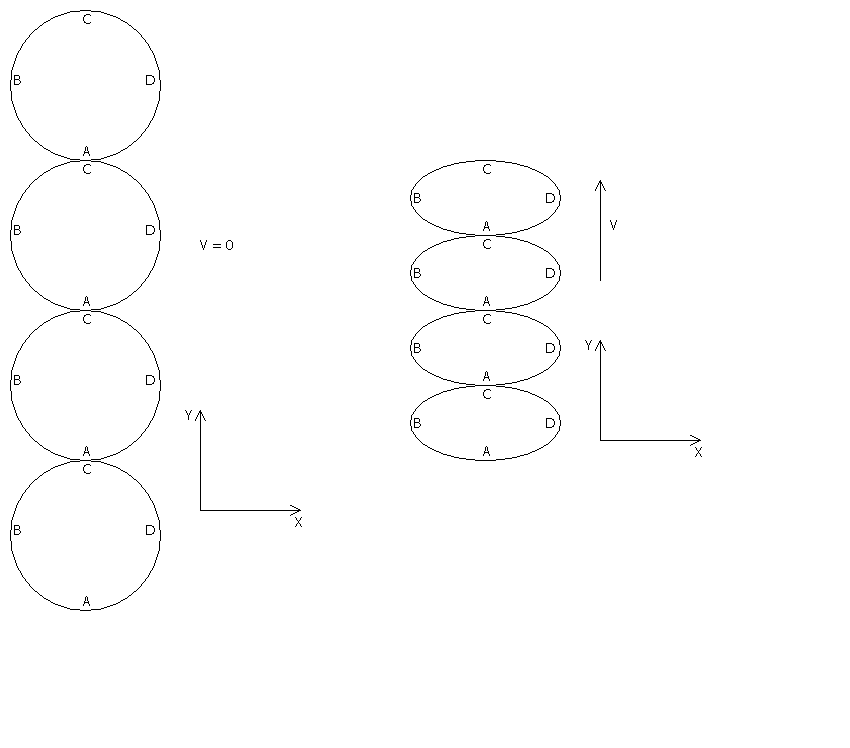
Figure 2. A cartoon of four atoms within a spring. Left half of the figure corresponds to a spring at rest with respect to a Lorentzian ether. Right half of the figure corresponds to a spring moving at velocity v with respect to such an ether. The velocity v is assumed to be in the y direction. The spring extends in the y direction.
Sherwin realized that the length contraction proposed by Lorentz was different than that proposed by Einstein. The Lorentz contraction was real, whereas the Einstein contraction was relative. Hence, since any frame is equivalent to any other in relativity, and the spring's motion in the earth-based inertial frame is symmetric about the center of motion, there is no orientation dependent length contraction predicted by special relativity as determined by an earth based observer. Since any inertial frame is as good as any other in special relativity, the prediction made by special relativity is that no resonant oscillations of the spring should be observed. However, for the real length contractions of the Lorentz theory, the spring should truly contract along its long dimension when it is aligned with it's velocity through the ether. The Lorentzian situation is shown in Figure 3.


Figure 3. A cartoon of four atoms within a spring moving through a Lorentzian ether in the y direction at velocity v. Top half of the figure corresponds to a spring oriented along its direction of motion. Bottom half of the figure corresponds to an orientation perpendicular to the direction of motion.
By synchronizing the rotational motion of the spring with the spring's natural harmonic motion, Sherwin hoped to excite resonantly driven harmonic oscillations of the spring. His argument was that length disturbances should propagate no faster than the speed of sound throughout the spring, since that is what they do in any other type of length disturbance. Therefore, when the longer spring (extended along x) rotates 90 degrees (so that it extends along y) there isn't enough time for it to come to its new equilibrium, and the natural F=kDx forces (from Hooke's Law) will excite oscillations.
Sherwin found no such oscillations. He took this to indicate a lack of a Lorentz contraction. In my original work (reference 1) I found nothing wrong with Sherwin's original arguments, so I pointed to his experiment as providing evidence that a length contraction did not exist in nature. However I now realize that both Sherwin and I were relying on an unmentioned assumption. We both assumed that the spring was a rigid body - rigid all the way down to its atomic connections. Looking again at Figure 3, I am assuming that the connection between atoms is always such that point A connects to point C. That is, I assume that there is a rigid connection point between each atom, and that as the spring revolves, the centers of the atoms revolve around the spring's rotation point, and the atoms themselves rotate once as they revolve, ever keeping points A and C connected between each atom in the spring.
But there is another possibility. Rather than being rigidly connected at points A and C, it is possible that the individual atoms slide along their common boundary as the spring is rotated. This situation is shown in Figure 4.
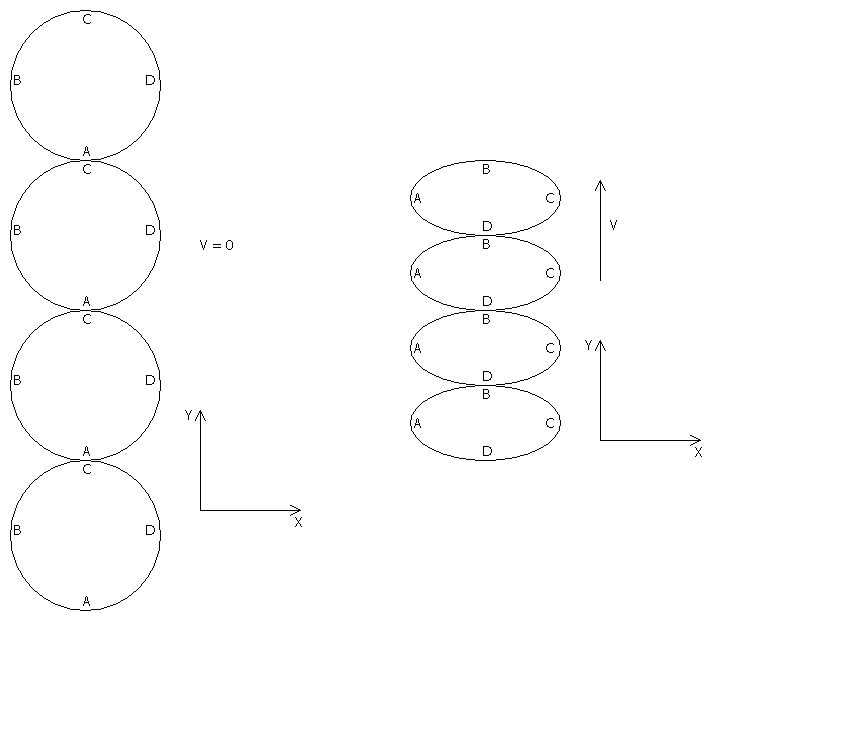

Figure 4. A cartoon of four atoms within a spring moving through a Lorentzian ether in the y direction at velocity v. Top half of the figure corresponds to a spring oriented along its direction of motion. Bottom half of the figure corresponds to an orientation perpendicular to the direction of motion.
The situation is further clarified in Figure 5. Figure 5 shows five atoms within the spring in three possible orientations. If the spring is rotating counterclockwise in the figure, the atoms start out with their points A and C in contact. After less than a 90 degree rotation, the atoms are still in contact, but now they are not in contact at points A and C. After a 90 degree rotation, the atoms have their points B and D in contact.
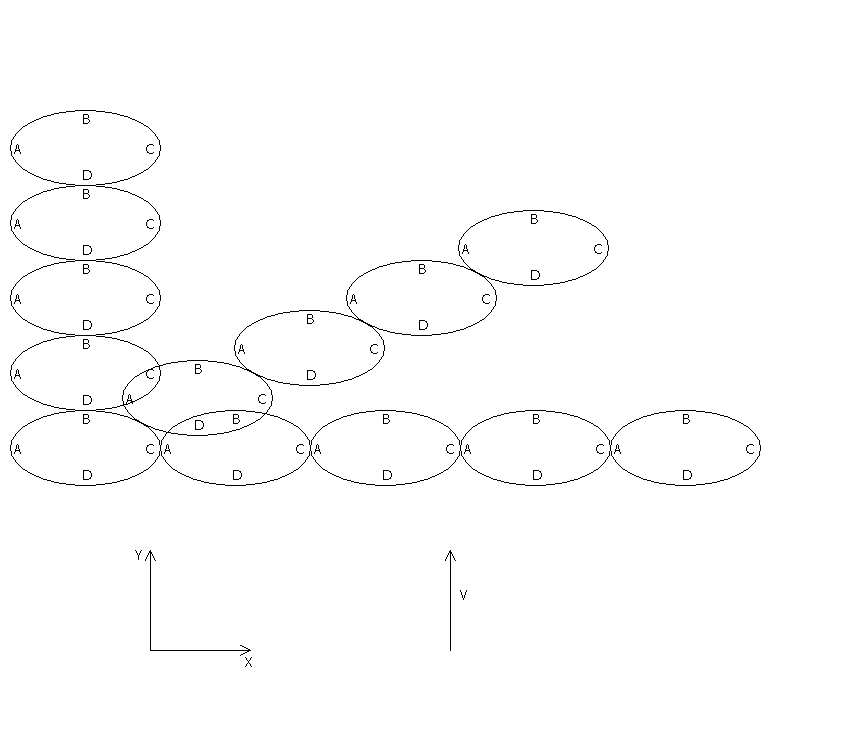
Figure 5. A cartoon of five atoms within a spring moving through a Lorentzian ether in the y direction at velocity v in three rotated positions.
If the atoms slide along their common boundary, Figure 5 shows how a null result of Sherwin's experiment can be obtained within a Lorentzian ether. Rather than the speed of the length contraction be required to propagate along the spring at the speed of sound, the length contraction is already there! It is just that the contact point moves along the atomic boundaries as the spring is rotated.
The simple diagrams above show the relevance of slippage versus rigid contact in one dimension. But of course the springs are three dimensional. Still, the same principle can be shown to apply for three dimensional objects. Figure 6 shows the case of two rows of atoms within a spring. Again, if the atoms slide along their common point of contact they are able to smoothly transition from the case of a longitudinal length contraction of the spring to that of a transversely contracted spring. For the case of three dimensions one would only need to add atoms centered above and below the gaps between the two dimensional image shown in Figure 6.
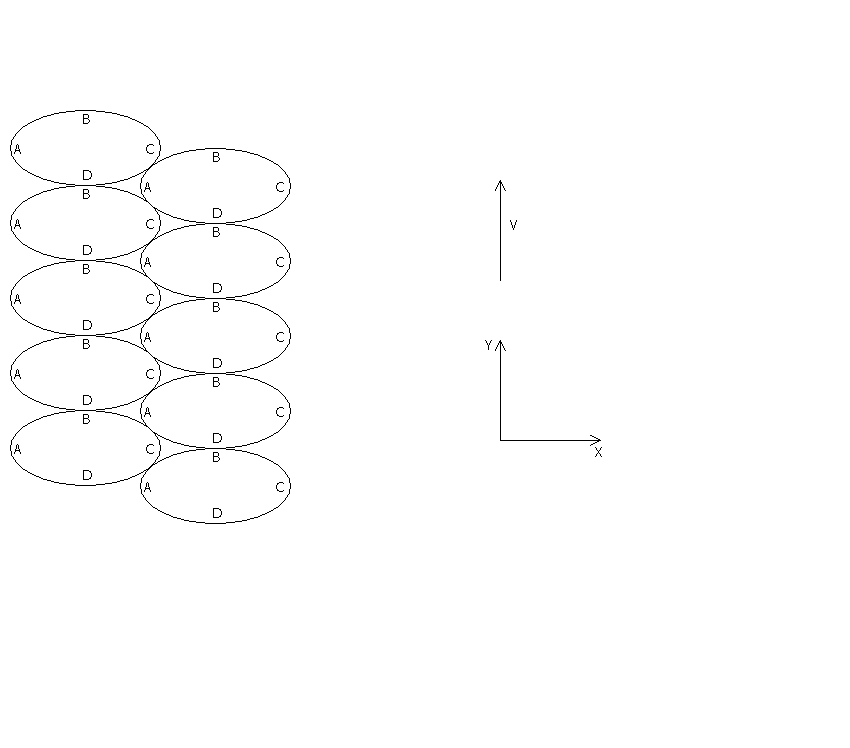
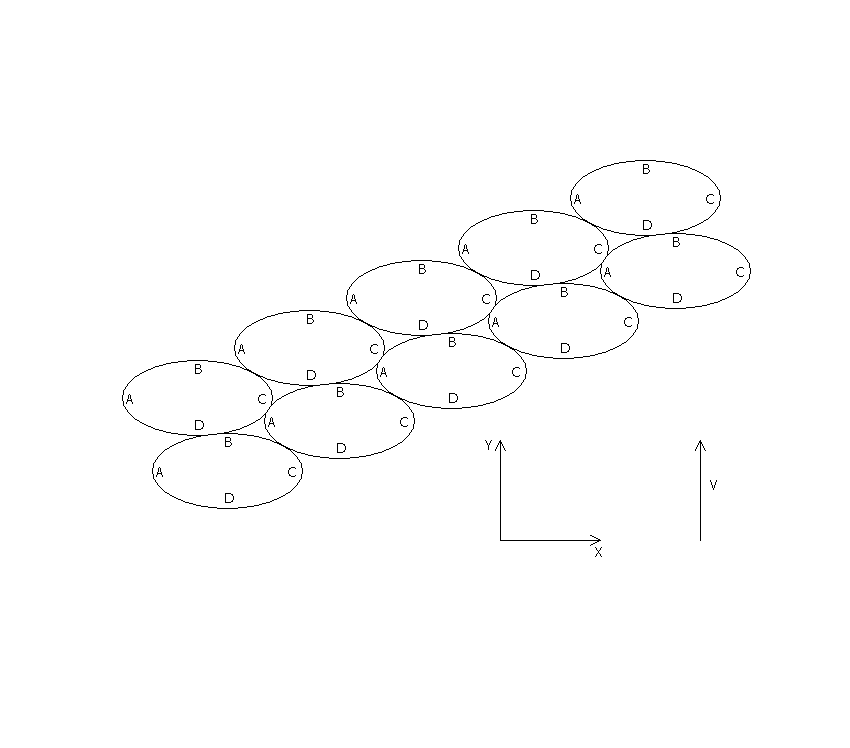
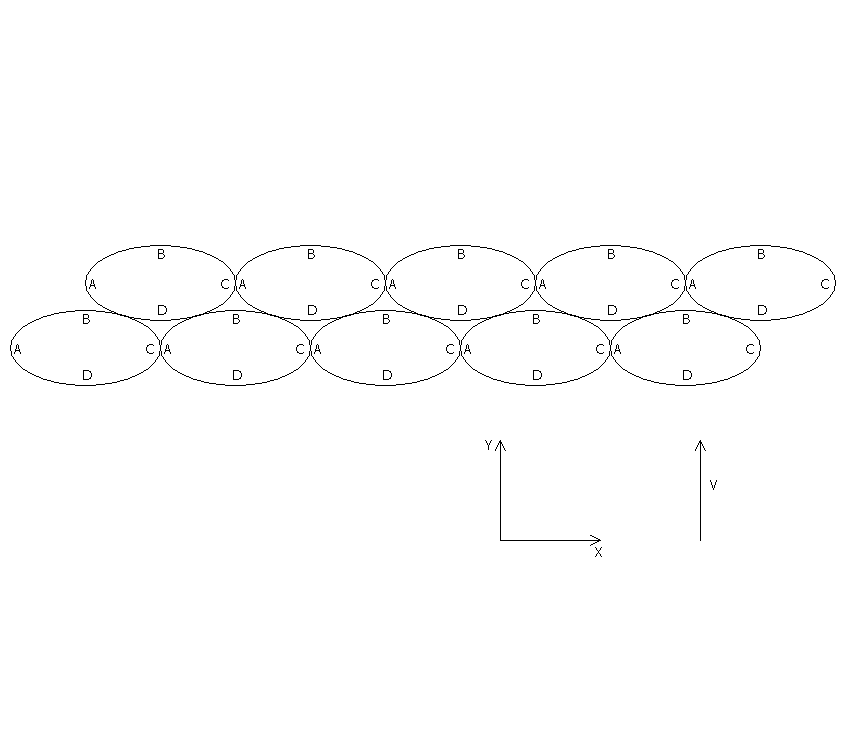
Figure 6. A cartoon of ten atoms within a spring moving through a Lorentzian ether in the y direction at velocity v in three rotated positions.
From the above analysis it can be seen that if solids behave such that the individual atoms within them slide along their common boundary as they rotate, then the null result of Sherwin's experiment can be understood even in the presence of a Lorentzian ether. If however, individual atoms within a solid maintain rigid contact at the atomic level, Sherwin's original arguments remain valid. Once again, an underlying assumption about nature must be made in order to interpret the results of an experiment. Therefore no conclusive statement can be made concerning whether or not Sherwin's experiment can be used to rule out (or in) any particular space time theory.
Earth Tides.
An additional experiment has also been conducted since the time that I wrote reference 1 that has bearing on the question of length contraction. CERN researchers have detected changes in the time it takes particles to orbit their particle storage rings and have correlated those orbital period changes to lunar position. From these experiments they have inferred a change in path length that the particles must have traversed, assuming that the speed of the particles was constant. (At LEP, under standard relativity or the Lorentzian theory, the electron velocity is constant and extremely close to the speed of light.)
These experiments could, in principle, be used as evidence for or against a length contraction. If there were no Lorentzian length contraction, and if Lorentzian time dilation alone is responsible for our inference of a length contraction (as shown in detail in reference 1), and if the speed of the particles is indeed constant, then the daily rotation of the earth could lead to different orbit times for the orbiting particles as a function of time of day.
A full analysis of the LEP observations is very worthy
of future study.
Conclusion.
At the time I wrote my earlier work (reference 1) I concluded that the experimental situation was not entirely clear as to whether or not nature contained a length contraction. By looking at all of the experimental evidence, it is clear that Einstein's relativity is the most in doubt, because of the experimental tests (reference 6) of Bell's Theorem (reference 7). At that earlier time I stated that the experiment of Sherwin appeared to support the case that there was no length contraction, but that Lorentz's theory should not be ruled out solely due to Sherwin's result. However, given my understanding of the experimental situation at the time, I made the point that there was some suggestion in the experimental data that a length contraction does not, in fact, exist.
With the further analysis done herein it is now clear that Sherwin's test does not clearly indicate whether or not a Lorentzian length contraction exists. In addition, further analysis of the situation with regard to earth tide measurements at CERN may provide some suggestion that a length contraction does exist.
But even with the additional insight and experimental data, I remain firm in my conviction that it will remain questionable whether or not there is a length contraction until a definitive experiment can be done. A definitive experiment could involve accelerating spheres of sufficient size so that ultrashort laser pulses could be fired across the spheres as they move. Then, the shadows thereby produced could be measured. The spheres would then have to be slowed down and brought to rest again. By measuring their size, as determined by the shadows of the light, both before, during, and after their motion, a unique measurement could be done concerning length contraction. (The before and after measurements are required in order to ensure that the spheres are not somehow mechanically altered during the acceleration and deceleration processes.) While even that experiment might be questioned (as can any experiment) it would be a far more direct measurement of length contraction than anything done to date.
As of July, 2002, it is still not proven that a length contraction exists.
References.
- - - - -
Delbert Larson, Ph. D. in Physics in 1986, in the field of particle accelerators, has published over 50 papers on a variety of physics topics. He has designed and built several complete particle accelerator systems over the years, including a 2.5 MeV, ampere intensity electron beam system and a 10 MeV He-3 ion beam system for PET isotope production. He served as a leading designer of the cancelled Superconducting Super Collider, doing longitudinal dynamics designs for that lab. Dr. Larson has written computer applications for space charge inclusive transverse ion optics and a separate code for longitudinal particle optics. Dr. Larson's computer codes have been used at laboratories around the world. Dr. Larson is presently leading the design of particle accelerators for use in medical therapy.
Delbert7@aol.com